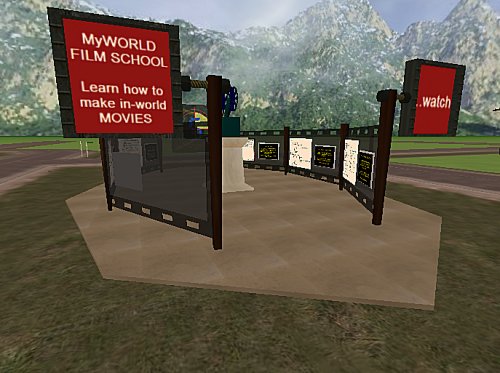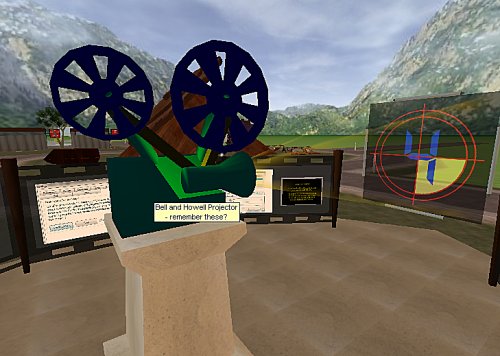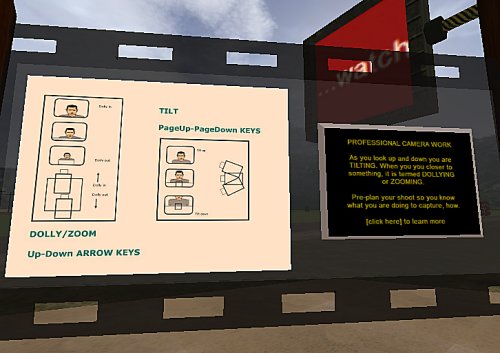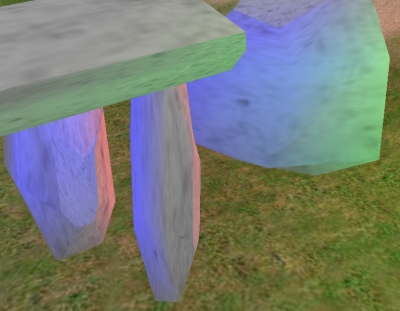…you ought to be in movies
…so Cybernauts will need to present their final contributions, and one format will be in-world machinima, so I set about thinking about how to best teach how to do this.
I have fond (if wildly inaccurate) memories of the old clackety film projectors we had when I was in school, so set about modelling one in Wings3D
While I was there, I also made a “wall” that is to be used as a sort of noticeboard on which I post tutorials and how-to’s. I thought the filmstrip metaphor would be a useful one so used that – I suspect however, our cybernauts have NEVER even seen actual film (that flimsy semi-transparent media we used to entrust our visual records to) – good or bad I do not know. I am not sure how I feel about the move to entirely digital records, particularly of things that are important – I guess they will never be accidentally deleted or become corrupt, hey?
With assets in-hand, I entered the world, set up an area in the tutorial zone, wired it to be the next stop in the guided tour and began decorating it with film-making resources
I popped the projector on a pedestal (where it belongs :P) and began animating and lighting it – the reels move at different speeds, as they did in real life, and I found a rather nice animated test pattern, and fashioned a transparent flickery light beam to add to the effect. Surrounding this I set about arranging display panels.
The aim was to “keep it simple, stupid”. Fortunately the in-world video capture system is pretty simple actually, so I aimed to show budding Spielbergs how to get to it, how to drive it and what the settings mean, briefly.
As well as how to fire up the recorder, I thought it relevant to introduce some film language as well – tilt/pan, dolly/truck are all important – we do them without thinking but I thought that surfacing the terms explicitly the kids could have much better discussions when planning their movies.
Rather than just post static resources, I thought a little meta-machinima was in order (machinima about making machinima) – check it out
Quite happy with the resultant tutorial – will it work with the punters – no idea – I guess we will find out.
I am not sure if I should also post info on storyboarding to formalise their planning – certainly the productions will be better quality if they are planned but i am not sure – what do you think?
Lights, Camera …
So, bored with the flat, uniform lighting and wanting to get a little moody, I set about first investigating lighting.
The “world” settings can vastly effect the mood of a place – the “ambient light” [general, non-directional ambiance] and “directional light” [that coming straight from the “sun”] can be bright and cheery, dark and dank and everything in-between. You control the “colour” of the light and therefore the intensity/luminosity by the density of colours you choose – all very nice. I am wondering if an admin “bot” might not be able to programatically change these settings, I should think this would then give us night/day as the bot could do this change gradually, using world time. Anyways, i dimmed the settings on Q2 a little, so it was not quite so sunny and cheery …
As it turns out, most things can contain a “light”, so I went for some rock’n’roll lighting with part of Wonkyhenge to create a myriad of reflections and other cheesy fx and the result ..
..was actually quite satisfactory. There are LOTS of things that can be varied about each light source [note to self – the light source does not actually illuminate ITSELF – each of the rocks in this part of Wonkyhenge is a light source – you see the colour from other rocks, if that makes sense]. There are “point” lights [like a bare incandescent bulb that spreads outwards from that point] and “spot” lights that shoot out a cone of directed light [you specify the direction, intensity, cone dynamics etc] – both nice. Obvious controls exist for colour [using named values or hex html refs, so 16.7 million shades might just be enough; note to self: kids will learn to spoll colour wrongly because for it to work in script, it must be spolled color – *shakes fists at Americans*], brightness [ intensity] and radius [spread].
A rather nice collection of fx exist for lights as well – blink, fadein/out, fire [a lovely faux flame flicker], flicker [like a fluoro tube going bung], flash [like lightning] and pulse [a rhythmic throbbing] – most fx have a time parameter to control the rapidity of them also, again, very nice. I can see lots of applications here [particularly when I get around to discovering fire in rockshop.
It seems most typed of objects can also be defined as a “camera”.
…so what I did, after an idea I saw in the Activeworlds Forum was define an object, set it rotating [to be my camera] and then defined a clickable somewhere else that would switch the user’s view to that camera object [in effect, creating a “guided tour” that followed the animation of the object].
Camera: create name wonkycam, visible yes, solid no, rotate 2 time=8 loop
Remote: activate camera location=wonkycam
meaning, the “camera” object is rotating at 2rpm, for 8 seconds, then returning to it’s original position in 8 seconds and repeating that. The “remote” transfers the user who clicked on it’s vision to the camera object, so you see what the object pans past – nice
Walk-throughs and guided tours are possible using this trick [note to self, explore animation and path-controlled movement more], as is “remote sensing” of far-away places without actually leaving the comfort of your current location – very useful. Lots more to explore, will keep banging the rocks together.






